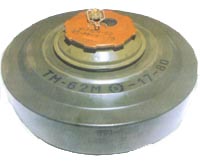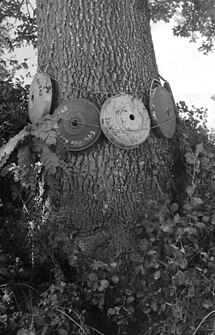Related Research Articles

The Tellermine 42 (T.Mi.42) was a German metal-cased anti-tank blast mine used during the Second World War. The mine was a development of the Tellermine 35 with improved resistance to blast. It was followed by the simplified Tellermine 43.

The Tellermine 43 was a German circular steel cased anti-tank blast mine used during the Second World War. It was a simplified version of the Tellermine 42, which enabled simpler production techniques. Between March 1943 and the end of World War II, over 3.6 million Tellermine 43s were produced by Germany. Copies of the mine were produced by several countries including Denmark (M/47), France and Yugoslavia (TMM-1).
The L9 bar mine is a large rectangular British anti-tank landmine. The bar mine's principal advantage is its long length, and therefore its trigger length. A typical anti-tank landmine is circular, and a vehicle's wheels or tracks, which make up only a small proportion of its total width, must actually press on the mine to activate it. To increase the probability of a vehicle striking the mine, the mine's effective trigger width must be increased.

Anti-personnel mines are a form of mine designed for use against humans, as opposed to anti-tank mines, which are designed for use against vehicles. Anti-personnel mines may be classified into blast mines or fragmentation mines, the latter may or may not be a bounding mine.
The PMN series of blast anti-personnel mines were designed and manufactured in the Soviet Union. They are one of the most widely used and commonly found devices during demining operations. They are sometimes nicknamed "black widow" because of their dark casings.

The VS-50 is a circular plastic cased anti-personnel blast mine that entered production in 1985, formerly manufactured by the now-defunct Valsella Meccanotecnica SpA, an Italian high-tech defence industry specialized in area denial systems which was also the manufacturer of the Valmara 69 and one of the first industries in the world to implement plastic construction for landmines. The design is similar to the TS-50 and VS-MK2 mine. It is blast resistant and can be used in a minimum metal configuration. Though unlikely to kill, the explosive charge contained within a VS-50 is quite sufficient to destroy the victim's foot: the blast is capable of penetrating 5 mm of mild steel leaving an 80 mm-diameter hole.

TM-62 is the designation for a series of Soviet anti-tank blast mines. The mines have a central fuze and typically have a 7.5 kilograms (17 lb) explosive charge, however they vary greatly in detail. The mines can be laid manually or automatically from a mine laying machine including the PMR-1, PMR-2 wheeled towed mine layers, the GMZ tracked mine laying vehicle and the VMR-2 helicopter mine laying system.
The SACI is an Italian Bakelite cased minimum metal anti-tank blast landmine. A number of variants were produced with varying amounts of explosive. The mine has three fuze wells on the top surface, that are covered with a pressure plate. Several types of fuzes were made including a low metal fuze. Combined with the low metal fuze the mine is very difficult to detect with mine detectors.
The SB-81 is an Italian plastic cased minimum metal anti-tank blast mine dating from the early 1980s. The mine uses an air pressure based fuze, which gives it protection against overpressure and blast. It can therefore be regarded as a blast resistant mine. The mine can be scattered by hand or by mine laying systems.

The Anti-Tank Mine, General Service, Mk V was a cylindrical, metal-cased United Kingdom anti-tank blast mine that entered service in 1943, during the Second World War. It was replaced in British service with the Mk 7 mine. Two versions of the mine were produced, the Mk. V and the Mk. VC with the same external dimensions. The only difference was that the Mk. VC had a half-sized explosive charge.

The TMA-3 is a circular Yugoslavian minimum metal anti-tank blast mine. It is very similar in appearance to the TMA-4. The mine consists of a cast circular block of explosive cased in resin reinforced fabric. The top of the mine has three fuze wells which each take a UTMA-3 fuze, and a fourth secondary fuze well is provided in the base of the mine to fit an anti-handling device. The fuze wells may also accept a number of other fuzes, including the UPROM-1, and other fuzes, potentially allowing tripwire activation. The small pressure plate area of the UTMA-3 fuzes gives the mine good resistance to minefield clearance techniques which used blast overpressure techniques i.e. explosive charges.
The Type 63 AT mine is a large circular Japanese minimum metal anti-tank blast mine. The mine does not float and is waterproof, enabling it to be used in shallow water. The mine uses a standard mechanical pressure fuze, with three ball bearings retaining a spring-loaded striker over a detonator assembly. The Type 63B variant has a secondary fuze well to attach an anti-handling device.
ADWAT is a French anti-tank blast mine used with the Matenin mine laying system. The mine has the same casing as the MI AC PR series of mines. The mine has a mechanical and electronic fuze. The mine incorporates a 30-minute arming delay, after which either the electronic or mechanical fuze can trigger the mine. The electronic fuze can be programmed using an external programmer with a three-pin connection to self-neutralize, self-destruct and act as an anti-handling device, with an active period of between one and 365 days.
The NR 25 is a circular Dutch steel cased anti-tank blast mine. It is broadly similar in appearance to the German Tellermine 43, although it is larger. The mine has a central domed pressure plate, underneath which is an NR-29 mechanical pressure fuze, which is inserted into a fuze well. A doughnut-shaped main charge surrounds a central booster charge. Two secondary fuze wells are provided on the side and base of the mine, for anti-handling devices.

The Teller mine was a German-made antitank mine common in World War II. With explosives sealed inside a sheet metal casing and fitted with a pressure-actuated fuze, Teller mines had a built-in carrying handle on the side. As the name suggests the mines were plate-shaped.

An anti-handling device is an attachment to or an integral part of a landmine or other munition such as some fuze types found in general-purpose air-dropped bombs, cluster bombs and sea mines. It is designed to prevent tampering or disabling, or to target bomb disposal personnel. When the protected device is disturbed, it detonates, killing or injuring anyone within the blast area. There is a strong functional overlap of booby traps and anti-handling devices.

The Anti-Tank Mine General Service Mark II was a British anti-tank blast mine used during the Second World War. It consisted of a body about 7.5 in (190 mm) in diameter and 3.25 in (83 mm). The mine has a central fuze well accessed from the bottom, with a main charge in a cavity around the well consisting of about 4 lb (1.8 kg) of TNT. The mine is fitted with a thin brass cover, which acts as a pressure plate. The cover is suspended over the main body of the main by four leaf springs. A Sorbo ring can be fitted between the cover and the mine body, which absorbs shock and blast and allows the mines to be planted as close as two feet (0.61 m) without causing sympathetic detonation.

The M1936 (Mle1936) is a French light anti-tank mine used during the Second World War. The mine was captured in large numbers by the German army after the Fall of France, and was later used in the Atlantikwall, North Africa and Italy. The mine consists of a base plate on top of which is a rectangular steel box containing an explosive charge. On top of the container are two M1935 or M1936 pressure fuzes. A pressure cover is fixed on top of the container by wires attached at either end of the container. Two pressure bars are welded to the inside of the pressure cover, each one is directly over a fuze—however, each bar has a recess preventing it from pressing on the pressure fuze, until a safety bar is inserted. The safety bar covers the recesses allowing the pressure cover to bear down directly on the pressure fuzes.

The Pignone mod.43 were bakelite cased Italian anti-tank blast mines used during the Second World War in North Africa and Italy.

The Wer'wolf MK2 is a Namibian designed and built military vehicle that offers protection against small arms fire and land mines. The vehicle uses a MAN chassis, axles and engine. The Wer'Wolf MK2 is a modular vehicle. It is built with a crew compartment that seats three people plus a driver and a rear flatbed configuration. The flat bed configuration allows for different modules to be fitted. It is suited for rough terrain, in APC configuration the Wer'Wolf MK2 can carry up to 10 passengers plus the driver. Designed and built in 1998 it was the first Mine Protected Vehicle manufactured by Windhoeker Maschinenfabrik after it was bought by Government of Namibia.
References
- 1 2 "Royal Ordnance Anti-tank Mine Mark 7 (United Kingdom), MINES". Jane's Military Vehicles and Logistics. Jane’s Information Group. Mar 20, 1995. Retrieved December 18, 2012.
- ↑ "United Kingdom". Landmine and Cluster Munition Monitor. Retrieved December 18, 2012.
- ↑ "Afghan bomb blast kills 10 girls". The Guardian. London. 17 December 2012. Retrieved December 18, 2012.